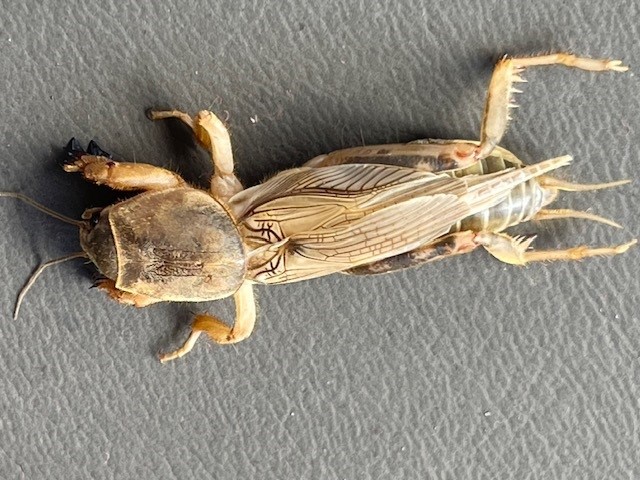Isaac Esquivel, Field & Forage Crop Entomologist, North Florida Research and Education Center, and Marcello Wallau, Forage Extension Specialist, UF/IFAS Agronomy Department
Dr. Wallau and I have been getting quite a few calls the past couple of weeks about mole crickets becoming problematic in pastures . They seem to be more active in the past two years, causing increasing problems for cattlemen. We wanted to provide a little information and background on the mole cricket and potential control mechanisms.
Three non-native species of mole cricket occur in Florida: the shortwinged mole cricket (Neoscapteriscus abbreviatus), the southern mole cricket (Neoscapteriscus borellii), and the tawny mole cricket (Neoscapteriscus vicinus) (Pictured). There is also a native non-pest mole cricket (Neocurtilla hexadactyla). It is important to identify what mole crickets are present but is fair to assume that if you see damage (not just signs of them), you probably have one of the problematic species. They are fairly easy to identify due to their size, and the key feature is their dactyls (Claws). Native mole crickets have four prominent claws on the forelegs, with two more on the rest of the legs giving six, while non-natives have two. For sampling protocol and identification information, use the following link: Mole Cricket IPM Guide for Florida.
=
The short-winged mole cricket occurs mainly in coastal regions with sandy soils and is flightless, so it has not spread as extensively as the other two species. The Southern mole cricket occurs across much of the Southeast, and is well distributed across all of Florida. The Southern mole cricket favors moist sandy soils. This mole cricket generally has one generation per year, but up to two in South Florida. Peak flights occur in April-June, with a minor flight in November. The tawny mole cricket is distributed throughout Florida and prefers well-drained, moist, sandy soils. This mole cricket also has one generation per year, with peak flights occurring in March-May and an additional flight in the fall. Egg hatch occurs in April-June, and nymphs develop for five months and reach adulthood in September. This is why most people see more damage in mid-to-late summer/early fall, when they are more active.
The most damaging of the three is the Tawny mole cricket, but all three can cause significant feeding injury in pastures and forage as they feed on plant roots, stems, and leaves and tunnel through the soil, disrupting the root systems. The size and extent of tunneling increase as the mole cricket ages. Unfortunately for pastures, there are no economically feasible or labeled insecticides for mole cricket control compared to turf and sod. Although there are some carbaryl (Sevin) baits labeled for pasture, they are more oriented for residential lawns and turf and not for large areas of coverage.
Things to take into account for mole cricket management are maintaining a healthy pasture with proper fertilization, irrigation, and grazing management. A lot of the decline in pasture conditions, be it from fungal disease, weed encroachment, or insect damage comes from weaker pastures, that have not been fertilized recently, and especially when potassium has become deficient. Improving growing conditions, making sure nutrients are available (soil pH), and avoiding overgrazing, results in an overall healthier pasture that can withstand challenges much better.
Two biological control agents work fairly well at suppressing populations of mole crickets. The first is an entomopathogenic nematode, Steinernema scapterisci, which was introduced from South America and widely applied across Florida up until 2012. Unfortunately, commercial production of this nematode has since ceased, but populations still exist in the environment. There was also the introduction of the Lara Wasp, Larra bicolor, which was introduced from South America in the 1980s. It has since been established across the state. This wasp only parasitizes species in the genus Neoscapteriscus (only the invasive species) and lays a single egg on each mole cricket. Larvae feed on the cricket, killing it as it develops. Lara wasp populations could be bolstered by providing nectar resources to sustain their foraging. We are working to identify possible alternative nectar sources for Lara wasp as previous recommendations turned out to be invasive and a hard to kill weeds in pastures if not controlled. Buckwheat (Fagopyrum esculentum) seems to be a promising alternative, which we plan to research further.
Please feel to reach out to us for more information or questions at: forages@ufl.edu
- Cotton Pest Update: Stink Bugs and New Invasive Cotton Pest – Two-Spotted Cotton Leafhopper, Moving into Cotton - July 11, 2025
- Early Season Thrips Management in Cotton and Peanut 2025 - April 25, 2025
- ThryvOn Cotton in the Florida Panhandle – Summary of Trial Data at UF/IFAS NFREC Quincy - October 25, 2024

